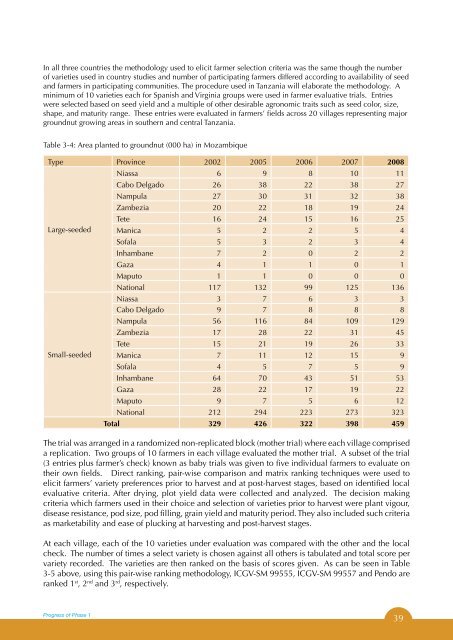Final version of Tropical Legumes II Project Report for Phase 1 - icrisat
Final version of Tropical Legumes II Project Report for Phase 1 - icrisat
Final version of Tropical Legumes II Project Report for Phase 1 - icrisat
Create successful ePaper yourself
Turn your PDF publications into a flip-book with our unique Google optimized e-Paper software.
In all three countries the methodology used to elicit farmer selection criteria was the same though the number<br />
<strong>of</strong> varieties used in country studies and number <strong>of</strong> participating farmers differed according to availability <strong>of</strong> seed<br />
and farmers in participating communities. The procedure used in Tanzania will elaborate the methodology. A<br />
minimum <strong>of</strong> 10 varieties each <strong>for</strong> Spanish and Virginia groups were used in farmer evaluative trials. Entries<br />
were selected based on seed yield and a multiple <strong>of</strong> other desirable agronomic traits such as seed color, size,<br />
shape, and maturity range. These entries were evaluated in farmers’ fields across 20 villages representing major<br />
groundnut growing areas in southern and central Tanzania.<br />
Table 3-4: Area planted to groundnut (000 ha) in Mozambique<br />
Type Province 2002 2005 2006 2007 2008<br />
Niassa 6 9 8 10 11<br />
Cabo Delgado 26 38 22 38 27<br />
Nampula 27 30 31 32 38<br />
Zambezia 20 22 18 19 24<br />
Tete 16 24 15 16 25<br />
Large-seeded Manica 5 2 2 5 4<br />
S<strong>of</strong>ala 5 3 2 3 4<br />
Inhambane 7 2 0 2 2<br />
Gaza 4 1 1 0 1<br />
Maputo 1 1 0 0 0<br />
National 117 132 99 125 136<br />
Niassa 3 7 6 3 3<br />
Cabo Delgado 9 7 8 8 8<br />
Nampula 56 116 84 109 129<br />
Zambezia 17 28 22 31 45<br />
Tete 15 21 19 26 33<br />
Small-seeded Manica 7 11 12 15 9<br />
S<strong>of</strong>ala 4 5 7 5 9<br />
Inhambane 64 70 43 51 53<br />
Gaza 28 22 17 19 22<br />
Maputo 9 7 5 6 12<br />
National 212 294 223 273 323<br />
Total 329 426 322 398 459<br />
The trial was arranged in a randomized non-replicated block (mother trial) where each village comprised<br />
a replication. Two groups <strong>of</strong> 10 farmers in each village evaluated the mother trial. A subset <strong>of</strong> the trial<br />
(3 entries plus farmer’s check) known as baby trials was given to five individual farmers to evaluate on<br />
their own fields. Direct ranking, pair-wise comparison and matrix ranking techniques were used to<br />
elicit farmers’ variety preferences prior to harvest and at post-harvest stages, based on identified local<br />
evaluative criteria. After drying, plot yield data were collected and analyzed. The decision making<br />
criteria which farmers used in their choice and selection <strong>of</strong> varieties prior to harvest were plant vigour,<br />
disease resistance, pod size, pod filling, grain yield and maturity period. They also included such criteria<br />
as marketability and ease <strong>of</strong> plucking at harvesting and post-harvest stages.<br />
At each village, each <strong>of</strong> the 10 varieties under evaluation was compared with the other and the local<br />
check. The number <strong>of</strong> times a select variety is chosen against all others is tabulated and total score per<br />
variety recorded. The varieties are then ranked on the basis <strong>of</strong> scores given. As can be seen in Table<br />
3-5 above, using this pair-wise ranking methodology, ICGV-SM 99555, ICGV-SM 99557 and Pendo are<br />
ranked 1 st , 2 nd and 3 rd , respectively.<br />
Progress <strong>of</strong> <strong>Phase</strong> 1<br />
39
















